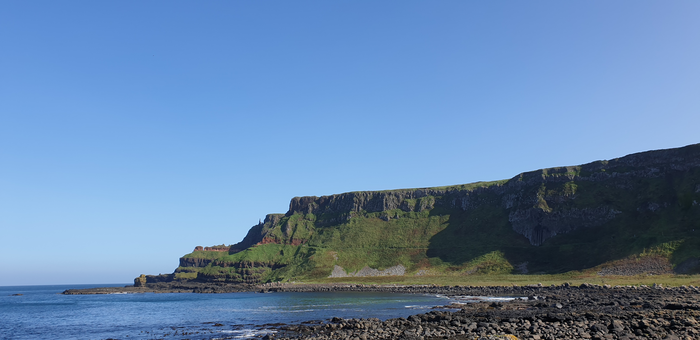A massive release of greenhouse gases, likely triggered by volcanic activity, caused a period of abrupt global warming known as the Paleocene–Eocene Thermal Maximum (PETM) 56 million years ago. A new study confirms that there was a second, smaller rise in atmospheric CO2 just before the PETM, with total carbon emissions similar to today’s levels.
 Giant’s Causeway, Northern Ireland.: Basalt rock exposures of North Atlantic volcanism during the time of the PETM. Image Credit: Tali Babila, University of Southampton.
Giant’s Causeway, Northern Ireland.: Basalt rock exposures of North Atlantic volcanism during the time of the PETM. Image Credit: Tali Babila, University of Southampton.
This resulted in a brief period of warming and acidification of the oceans. These two events, taken together, provide unique insights into how Earth’s current climate might respond if carbon emissions continue to rise.
Marine sediments containing the ancient remains of foraminifera, a group of microscopic organisms preserved as fossils, show evidence of environmental change at the PETM. Scientists can determine the temperature and pH of the oceans millions of years ago by analyzing the chemical composition of foraminifera shells.
The PETM is an important geologic climate event because it is one of best comparisons to current climate change and can help inform us how the Earth System will respond to current and future warming.
Dr. Tali Babila, Study Lead Author and Postdoctoral Research Associate, University of Southampton
Despite years of research, the sequence of environmental changes leading up to the PETM has remained a mystery because the start of the event was nearly erased in almost every marine record, until now, by the ocean acidification that took place.
Drilling sediment cores along the eastern United States, now part of the Atlantic Coastal Plain, a group of international geoscientists headed by the University of Southampton and University of California Santa Cruz, as well as Utah State University, KU Leuven, Penn State, and the US Geological Survey, overcame the lack of fossils from the time.
This region was a shallow continental shelf at the time of the PETM, which provided higher sedimentation rates given the proximity to land and some protection from ocean acidification, preserving some of the missing sediment record.
The researchers then used a ground-breaking laser sampling technique developed on fossilized plankton shells in sediment samples. They sampled microscopic plankton with a laser beam the width of a strand of human hair and sent the vaporized particles to a mass spectrometer. The boron chemistry of the shell was analyzed and used to estimate the acidity and thus carbon content of the oceans at the time.
The findings provided evidence for a significant increase in carbon emissions just before the PETM began, on the order of what we see released by human activities today. The study was published in the journal Science Advances.
This had previously been suggested as a possible trigger for the large scale global warming that followed but scientists lacked a direct measure of carbon dioxide until this study.
Dr. Tali Babila, Study Lead Author and Postdoctoral Research Associate, University of Southampton
Dr. Babila adds, “Usually, this type of analysis would require thousands of fossils which would not have been possible because of the scarcity of samples. Our novel application of the laser sampling technique is a major geoscience advancement bringing new and incredible detail never before seen in Earth’s past.”
The findings enable the researchers to draw closer parallels with anthropogenic climate change. The short-lived precursor event seems to be more akin to what might happen if carbon emissions were rapidly reduced, whereas the PETM’s larger carbon release more closely resembles the likely environmental consequences of continuing on the current path of rising atmospheric carbon dioxide emissions.
Whilst natural geological processes such as rock weathering and carbon burial eventually meant Earth eventually recovered from the PETM, it took hundreds of thousands of years. So this is further proof that urgent action is needed today to rapidly cut the amount of carbon being release into the atmosphere to avoid long-lasting effects.
Dr. Tali Babila, Study Lead Author and Postdoctoral Research Associate, University of Southampton
Ancient greenhouse warming event informs potential future climate scenarios.
Video Credit: University of Southampton.
Journal Reference:
Babila, T. L., et al. (2022) Surface ocean warming and acidification driven by rapid carbon release precedes Paleocene-Eocene Thermal Maximum. Science Advances. doi.org/10.1126/sciadv.abg1025.